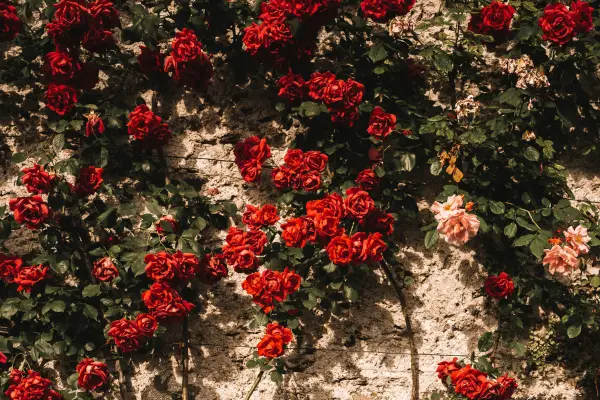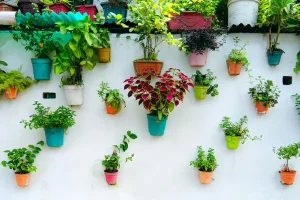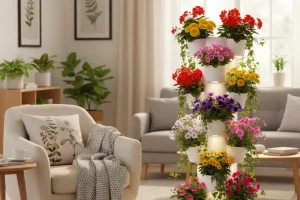Want a wall of color without giving up precious floor space? Climbing flowers are the secret of small gardens, balconies, and patios. They race up trellises, fences, and arches, turning plain vertical surfaces into living art. In this guide, you’ll meet ten reliable climbers, learn where they shine, and get simple steps to train and care for them.
Why Climbing Flowers Belong in Vertical Gardens
Vertical gardens are all about using height, not width. Flowering climbers make that height work harder by adding:
- Big impact in a tiny footprint: Perfect for balconies and narrow side yards.
- Privacy and soft shade: Screen a view or cool down a sunny wall.
- Pollinator power: Many climbers attract bees, butterflies, and hummingbirds.
- Season-long color and fragrance: Choose a mix so something is always in bloom.
A good match comes down to light, climate, support, and maintenance time. Keep those in mind as you pick your favorites below.
The Top 10 Climbers
1) Clematis (Clematis spp.)
Why it shines: Hundreds of varieties, from dinner-plate blooms to delicate bells, in nearly every color.
Best for: Sunny to part-shade walls and trellises; gorgeous over archways.
Light & water: 6+ hours of sun is ideal, but many types like cool roots mulch the base or plant low perennials to shade the soil.
Notes: Pruning depends on variety (early, mid, or late bloomers). If you’re unsure, prune lightly after flowering and harder in late winter.
2) Climbing Roses (Rosa spp.)
Why it shines: Classic romance with repeat blooms and a soft scent.
Best for: Strong trellises, arches, and fences; cottage or modern spaces alike.
Light & water: Full sun (6–8 hours). Deep, regular watering; good air circulation to reduce disease.
Notes: Tie long canes horizontally along wires. This encourages more side shoots and more flowers.
3) Star Jasmine (Trachelospermum jasminoides)
Why it shines: Glossy evergreen leaves and a powerful, sweet fragrance in late spring and summer.
Best for: Warm patios, entryways, and balconies where scent can be enjoyed.
Light & water: Sun to part shade; moderate water.
Notes: Not a true jasmine but easier than many. Great in large containers with a trellis.
4) Bougainvillea (Bougainvillea spp.)
Why it shines: Neon bracts in hot pink, orange, red, and white. Wildly floriferous in heat.
Best for: Sunny, frost-free spots; south-facing walls.
Light & water: Full sun; let soil dry slightly between waterings.
Notes: Needs strong support and pruning to keep tidy. In cold climates, grow in a pot and overwinter indoors.
5) Passionflower (Passiflora spp.)
Why it shines: Exotic, intricate blooms and edible fruit on some species.
Best for: Fast coverage on fences and pergolas; wildlife-friendly gardens.
Light & water: Full sun to light shade; consistent moisture.
Notes: Can be vigorous. Train early. Choose a cold-hardy species if you get frost.
6) Honeysuckle (Lonicera spp.)
Why it shines: Tubular blooms that hummingbirds and bees adore; many are richly scented.
Best for: Pergolas and railings where fragrance can drift by seating areas.
Light & water: Sun to part shade; average water.
Notes: Pick non-invasive species or cultivated varieties suitable to your region.
7) Morning Glory (Ipomoea tricolor and hybrids)
Why it shines: Easy from seed with sky-blue, purple, or pink trumpets that open each morning.
Best for: Quick summer screens, rental-friendly trellises.
Light & water: Full sun; moderate water.
Notes: Annual in most climates. Self-seeds; deadhead if you want to control spread. Seeds can be toxix. Keep away from children and pets.
8) Black-Eyed Susan Vine (Thunbergia alata)
Why it shines: Cheerful orange, yellow, or white flowers with dark centers; compact growth.
Best for: Small trellises, balcony railings, and hanging obelisks.
Light & water: Sun to part sun; regular water.
Notes: Often grown as an annual but can be perennial in warm zones.
9) Mandevilla (Mandevilla/Dipladenia)
Why it shines: Large, glossy leaves and continuous tropical trumpets in pink, red, or white.
Best for: Warm patios, poolside trellises, and containers.
Light & water: Sun to bright light; steady moisture and monthly feeding in season.
Notes: Tender to frost—treat as an annual in cold regions or overwinter indoors with bright light.
10) Climbing Hydrangea (Hydrangea anomala subsp. petiolaris)
Why it shines: Elegant lacecap flowers and heart-shaped leaves; clings to surfaces with aerial roots.
Best for: Shade to part shade walls and sturdy fences.
Light & water: Cool, moist soil; protect from hot afternoon sun.
Notes: Slow to start but worth the wait. Heavy when mature. Use strong supports and keep off delicate structures.
How to Choose the Right Climber (Quick Matchmaking)
- For fragrance near doors/windows: Star jasmine, honeysuckle, climbing roses.
- For maximum color in heat: Bougainvillea, mandevilla, passionflower.
- For small, shady spaces: Climbing hydrangea (shade), certain clematis groups (part shade).
- For fast summer cover: Morning glory, black-eyed Susan vine, passionflower.
- For containers on balconies: Star jasmine, mandevilla, clematis (in a big pot), black-eyed Susan vine.
- For arches and pergolas: Climbing roses, honeysuckle, clematis combinations.
Step-by-Step: Training Climbers on a Trellis or Wall
- Pick the right support. Use weatherproof wood, metal, or sturdy plastic. For walls, add a 2–3 in gap behind the trellis for airflow.
- Set plant spacing. Most climbers like 12–24 in between plants; check labels for mature width.
- Plant with good drainage. Use quality potting mix in containers or improve garden soil with compost. Water deeply after planting.
- Attach main stems early. Use soft ties or clips every 8–12 in. Train stems horizontally where possible to encourage flowering side shoots.
- Guide, don’t strangle. Replace tight ties as stems thicken. Avoid wire cutting into bark.
- Prune with purpose.
- Clematis: follow variety group rules; when in doubt, prune lightly after bloom.
- Roses: remove dead or crossing canes; tie new growth sideways.
- Vigorous vines (passionflower, honeysuckle): thin out crowded stems to keep airflow.
- Feed in the season. Use a balanced, bloom-boosting fertilizer lightly every 4–6 weeks for heavy bloomers (check label). Stop feeding late in the season in cold climates.
Container Setup for Climbing Flowers
- Pot size: Start with at least 12–16 in diameter for most climbers; go larger for roses or hydrangea.
- Soil: Use high-quality, well-draining potting mix—never garden soil in pots.
- Watering: Containers dry faster; check moisture daily in hot weather. Water deeply until it drains out the bottom.
- Fertilizer: Slow-release granules at planting plus a liquid bloom feed every few weeks during peak growth.
- Winter: Move tender plants (bougainvillea, mandevilla) indoors before frost; keep bright and slightly dry.
Simple Care Routine (Cheat Sheet)
- Weekly: Check ties, guide new growth, remove spent blooms.
- Biweekly: Feed lightly during active growth.
- Monthly: Inspect for pests (aphids, spider mites). A gentle spray of water or insecticidal soap usually handles early outbreaks.
- Seasonal: Prune after flowering, refresh mulch, and clean supports.
Common Mistakes to Avoid (and the easy fixes)
- Planting sun-lovers in shade (or shade-lovers in sun)
Fix: Match plant to light. Hydrangea for shade; bougainvillea for full sun. - Weak supports that sag or snap
Fix: Use sturdy trellises and stainless screws. Remember: mature vines get heavy. - Tiny containers for big roots
Fix: Size up pots; bigger volume means cooler roots and steadier moisture. - Overwatering tropical vines
Fix: Let the top few centimeters of soil dry before watering again, especially for bougainvillea. - Skipping pruning
Fix: Light, regular trims keep vines flowering and prevent tangles. Learn your plant’s pruning season. - Letting aggressive vines smother neighbors
Fix: Thin stems monthly and keep a clear “ladder” for each plant to climb. - Ignoring regional invasiveness warnings
Fix: Choose non-invasive species and improved cultivars recommended for your area. - Safety blind spots
Fix: Some plants (e.g., morning glory seeds) can be toxic. Place out of reach of kids and pets.
Quick Pairing Ideas for a Longer Bloom Season
- Clematis + Climbing Rose: Rose for early and repeat blooms; clematis threads through canes for mid-season fireworks.
- Star Jasmine + Evergreen Trellis: Year-round green with a spring fragrance punch.
- Morning Glory + Black-Eyed Susan Vine: Fast, colorful summer duo for rental-friendly screens.
- Honeysuckle + Passionflower: Pollinator magnet pergola with scent and exotic blooms.
Conclusion: Build Your Vertical Bouquet
A vertical garden doesn’t need acres of space, just the right climbers and a simple plan. Start by matching light, climate, and support to the plants that fit your style. Want fragrance by the door? Try star jasmine or honeysuckle. Need instant summer color on a balcony? Go with black-eyed Susan vine or morning glory. Dreaming of classic romance? Train a climbing rose with a clematis.
Choose two or three from the list to stagger bloom times, add a sturdy trellis, and follow the training steps above. In a single season, you’ll be picking petals off your shirt and smiling every time you step outside.




